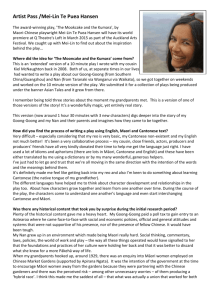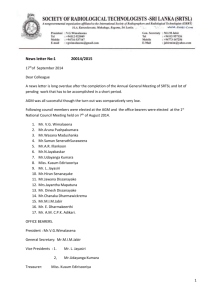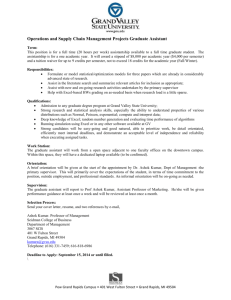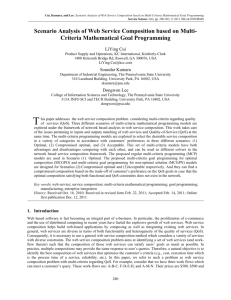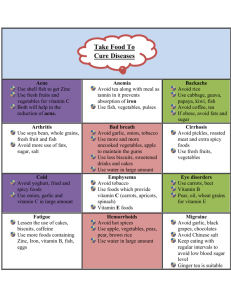12050 ABC Flash Cards 26 Letters.indd
advertisement
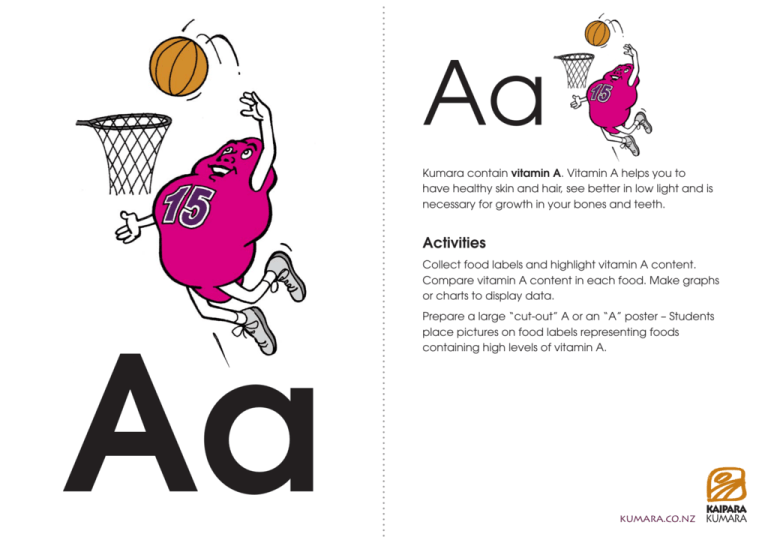
Aa Kumara contain vitamin A. Vitamin A helps you to have healthy skin and hair, see better in low light and is necessary for growth in your bones and teeth. Activities Collect food labels and highlight vitamin A content. Compare vitamin A content in each food. Make graphs or charts to display data. Prepare a large “cut-out” A or an “A” poster – Students place pictures on food labels representing foods containing high levels of vitamin A. Aa kumara.co.nz Bb When you eat kumara, you consume beta-carotene which the body uses to make vitamin A. Orange kumara are especially high in beta-carotene. This nutrient is very good for your eyes. Activities Administer the Snellin eye test to students in the class. Chart results. Use codes to assure student anonymity. The Snellin eye test is the one opticians use. You can download and print a copy of this test chart at: www.i-see.org/block_letter_eye_chart.pdf Bb Invite an eye care professional to speak to your class regarding eye health, nutrition, and safety. kumara.co.nz Cc Kumara are high in vitamin C. One medium-size kumara can contain 77% of the Recommended Daily Intake of Vitamin C. Vitamin C helps to heal wounds and prevent certain diseases. Activities Search the Internet for food and non-food sources of vitamin C. Create a pamphlet to inform readers of the importance of vitamin C in a diet. Distribute pamphlets to parents or at an upcoming school function. Cc Host a “C”licious tasting party. Serve kumara and other foods rich in vitamin C. This might be well timed during the “cold season”. kumara.co.nz Dd Diversity describes kumara well. They can be prepared and served in many ways. All of them are “D”licious! Activities Letter writing activity. Write to parents, grandparents and ask for kumara recipes. Practice letter writing skills and note procedures for mailing correspondence. Perhaps a trip to the Post Office is in order. Dd Develop and publish a Kool Kumara Cookbook. kumara.co.nz has some good recipe ideas. Use the computer to create printed pages with appropriate margins, spaces, etc. Add graphics. kumara.co.nz Ee E is for exercise and energy. To keep fit and healthy you need to eat foods which give you energy. The carbohydrate and sugar content of kumara helps us to be active as we work and play each day. Activities Locate resources related to the carbohydrate content of various foods. Ask students to bring along food labels from home and prepare a chart which lists the ingredients and nutrition values of typical foods. Especially carbohydrates. Ee Discuss the concept of energy in from food needing to equal energy out (exercise). Prepare a poster to communicate what happens when you eat more energy than you use. The body stores the excess food as fat. Take students for a long walk around the school. Measure the distance with a pedometer. Use this activity as a geography lesson by adding up the distance walked by each student and then looking at a local map to compare and understand distances to places of interest. kumara.co.nz Ff F is the fibre contained in kumara. Fibre is an important component of every diet. Kumara are a great source of dietary fibre. Activities Provide samples of raw and cooked kumara. Use a magnifying lens to look for fibres in the vegetable. Compare with samples of other high fibre foods, (apples, popcorn, etc). Have students to list descriptive words that tell what the fibre looks like in each food. Ff Create a poster showing a variety of high fibre foods. Display in the class. Expand the study of fibre to one of non-dietary fibre. Explore cotton, linen, and flax plants. Learn which fibres can be used for both food and apparel. kumara.co.nz Gg G is for gold kumara, recognised by its golden skin. It is known as the Toka Toka kumara, named after the distinctive mountain shape overlooking the Kaipara growing area in Northland. Activities Practice taste comparisons by tasting each of the 3 types of kumara red, gold and orange. Have students taste the raw kumara and ask them to use descriptive words to describe the different tastes. Gg kumara.co.nz Hh In the Kaipara region of New Zealand, kumara are a hot commodity. Commodities are products from nature that are produced on farms. Activities Make charts to show top agricultural commodities in New Zealand. Include the following information: • Commodity name. • It’s production ranking within the economy of New Zealand. Hh • Number of acres used to grow the kumara in New Zealand. • Regions in New Zealand where kumara are grown. kumara.co.nz Ii I is for the kumara industry in New Zealand. Growing, harvesting, processing, and marketing kumara go together to comprise an important industry in the Kaipara region of New Zealand. Activities Sequence pictures and descriptions that represent each activity involved in the production and marketing of kumara. What is the sequence of activities that move kumara from seedlings to our dinner tables? Ii Find out where growing and packing facilities are located in New Zealand. Write about (or visit these facilities) to find out about production, costs, transportation, career opportunities and other products produced in these regions. The website kumara.co.nz has good information. kumara.co.nz Jj Did you know you can drink red, orange or gold kumara as a juicy smoothie? But it is best to cook them first. Activities Try blending kumara and other vegetables and fruits into delicious smoothies. Cook a kumara until tender then blend and add other juices like apples, orange... even yoghurt. A great way to get good nutrition. Jj kumara.co.nz Kk Kool Kumara is a character created to represent and promote Kaipara Kumara. Activities Go to the website www.kumara.co.nz and find pictures of Kool Kumara in the kids section and classroom resources. Kk There are activities for students in different grades at your school. Prepare a memo about the website to other teachers in the school so their classes can enjoy the fun things that Kool Kumara has in store for them. Search the internet to find “mascots” that represent other agricultural products. Have children share their findings. kumara.co.nz Ll Some types of land are just right for growing kumara. Activities Contact Kaipara Kumara and ask why the soil in the Kaipara area is so good for growing kumara. Discuss their answer with students. Ask students to bring a small container of soil from their garden to class. Compare the soil and ask students to describe and write down the the differences. Ll Find out the best ways to fertiliser and enrich the soil plants grow in. kumara.co.nz Mm M is for Maori. The word kumara is a Maori name for this vegetable. Maoris brought a type of kumara to New Zealand over 1000 years ago. Activities Find out how the original Maoris of New Zealand planted, grew, harvested and stored kumara. Mm kumara.co.nz Nn N is for nutrition. Kumara are one of the most nutritious vegetables around. Activities Go to the web site www.kumara.co.nz and prepare a list of the main nutrients found in kumara. Then list the amount of energy, protein, fat, carbohydrate, fibre, sodium (salt) and Vitamin C an average size kumara contains. Nn kumara.co.nz Oo O is for orange kumara. Activities Use library books and the internet to find out which nutritional component in orange kumara gives them their orange colour. Find out why this colour is so good in the vegetables we eat. (carotene) Oo kumara.co.nz Pp P is for plate. To ensure that you are getting all the various nutrients you need, you should be sure that you see many colours on your plate for each meal. Kumara can add red, yellow and orange colour to your meal. Activities Pp Research the nutrients in green, red and orange vegetables and fruits. Make a chart to list the foods, the nutrients contained in each one, the recommended daily allowance of the nutrients, and how many servings you should consume each day. Use vegetables and fruits to create “stamps” and then make prints for the classroom. Have students write an imaginative narrative essay about the footprint of each fruit of vegetable. Ask an artist to visit your class to share with students how dyes are made from certain fruits and vegetables. Produce these dyes and make a related artistic display (dyes/paints fabric/paper collage). kumara.co.nz Farmers only want to grow top quality kumara. They take many steps to make sure their kumara are the best they can be. Activities When vegetables are sold at the supermarket or fruit and vegetable shop they are often “graded”. The best quality vegetables receive the highest grade and bring the best price. Discuss what attributes make vegetables and fruits qualify as the best. Compare these attributes to the criteria for top quality grades on school assignments. Prepare a checklist which outlines the qualities needed for superior grades! kumara.co.nz Rr Kumara and other agricultural products are produced in rural areas of New Zealand. Activities List synonyms for the word “rural” and describe these words. Create a diagram comparing and contrasting aspects of rural and urban lifestyles. Write a paragraph describing the community in which you live. Rr kumara.co.nz Ss Kumara plants grow from seedlings. They are grown very carefully to be sure the best possible plants can be planted out in the fields to help produce the best kumara possible. Activities Ss Watch how kumara grow by placing a kumara in a jar of water. Suspend the kumara in the jar with toothpics. Keep the jar full with water. Have students observe the root and leaf growth. Train the leaves up and over a framework or doorway. Discuss the need for water to produce quality plant growth. Ask Kaipara Kumara how they water and irrigate their growing kumara. kumara.co.nz Tt Farmers must operate on a specific timeline as they plant, tend and harvest their crops. They must know the correct growing season and abide by it in order to get a healthy and profitable crop. Activities Check library books and the internet about growing seasons for various vegetables. Tt Discuss which vegetables are best grown at various times throughout the year – season, climate, soil type, etc. Display and compare them in the classroom. Have your students develop timeline charts for kumara and other crops. Display and compare them. kumara.co.nz Uu Kumara roots are the part of the plant that grows underground. Activities Consult a book about plants or check the internet to find out the names of plant parts that all plants have. Find out which plant parts are unique to certain plants or plant groups. Which part of the plant is the kumara we love to eat. Find out if any plants have more than one part that people consume. List them. Uu kumara.co.nz Vv Kumara are a good gift to take when you visit a friend in need. They are nutritious and delicious and keep well. Activities Locate recipes for kumara. Make a dish you could take to a friend or prepare when a friend comes to visit. Prepare these dishes and serve as a part of an etiquette lesson. Employ math skills by doubling and/or halving recipes. Vv Take a field trip to a local nursing home. Take along kumara plants which have been rooted and will grow as houseplants in the rooms of the residents. Schedule return visits to check on the progress of the plants and to “catch up on the news” with your new friends. Take some kumara treats from your recipe search (include samples with a sugar substitute). kumara.co.nz Ww Do you know where to buy kumara. Kumara is available in supermarkets, fruit and vegetable store and markets. Activities Discuss all the places kumara is available for sale near your school. Arrange a class visit to a vegetable shop or supermarket to see how kumara and other vegetables are displayed. Ww Have the class prepare colourful posters to help sell kumara. What are the important words to use to make people want to buy them. Use words that describe the taste and why they are good for you. How big should the price be? Should there be a picture of the kumara or a photo of a delicious recipe? kumara.co.nz Xx Stands for all the eXtra Vitamin C you get from kumara. You get 77% of your Recommended Daily Intake of Vitamin C from one medium-sized kumara. Activities Prepare a list of fruit and vegetables such as kumara, carrots, tomatoes, oranges, onions, cabbage, as many as you wish. Research how much vitamin C is found in these fruits and vegetables. Prepare a colourful chart for the wall ranking those with the most vitamin at the top and those with the least at the bottom. Xx kumara.co.nz Yy We like to describe kumara as Yum! They can be prepared and eaten in so many ways, even eaten raw. Activities Find a recipe for each of the following. Write it out the recipe and draw the main ingredients alongside. Yy • • • • • snack drink soup meal cake or cookie kumara.co.nz Zz Zip Codes are Postal codes that help postal workers sort, route, and deliver mail efficiently. Activities Visit a Post Office to find out how mail is handled and delivered. Ask about how Postal Codes work so letters can be sorted and delivered. Ask for a map that shows all the Postal Codes in New Zealand. Use a Zip Code Map to display areas where kumara and other crops are grown in New Zealand. Zz kumara.co.nz

